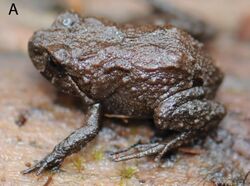Biology:Phrynopus
| Phrynopus | |
|---|---|

| |
| Phrynopus badius | |
| Scientific classification | |
| Domain: | Eukaryota |
| Kingdom: | Animalia |
| Phylum: | Chordata |
| Class: | Amphibia |
| Order: | Anura |
| Family: | Strabomantidae |
| Subfamily: | Holoadeninae |
| Genus: | Phrynopus Peters, 1873 |
| Type species | |
| Phrynopus peruanus Peters, 1873
| |
| Diversity | |
| 35 species (see text) | |
Phrynopus is a genus of frogs of the family Strabomantidae. Their common name is Andes frogs. They are endemic to Peru and inhabit the upper humid montane forest and supra-treeline grassland in the Cordillera Oriental, with one record from the Peruvian Cordillera Occidental.[1]
Taxonomy
The contents and phylogenetic position of Phrynopus have long been uncertain,[1] and many species once included in this genus have now been moved to other genera (Bryophryne, Lynchius, Isodactylus (now Hypodactylus), Noblella, Niceforonia, and Psychrophrynella).[2] Hedges and colleagues placed it in 2008 in the family Strabomantidae, subfamily Strabomantinae.[2]
Description
Phrynopus are small to medium-sized frogs, from 14.5 mm (0.57 in) snout–vent length in Phrynopus auriculatus to 54 mm (2.1 in) in Phrynopus kauneorum. Head is narrower than the body. Differentiated tympanic membrane and tympanic annulus are usually absent, except in Phrynopus auriculatus and Phrynopus peruanus, two basal species. Dorsum is smooth to pustulate. Venter is smooth or areolate.[2]
Species
The following species are recognised in the genus Phrynopus:[1]
References
- ↑ 1.0 1.1 1.2 Frost, Darrel R. (2022). "Phrynopus Peters, 1873". Amphibian Species of the World: An Online Reference. Version 6.1. American Museum of Natural History. https://amphibiansoftheworld.amnh.org/Amphibia/Anura/Brachycephaloidea/Strabomantidae/Pristimantinae/Phrynopus.
- ↑ 2.0 2.1 2.2 Hedges, S. B., Duellman, W. E., and Heinicke, M. P (2008). "New World direct-developing frogs (Anura: Terrarana): Molecular phylogeny, classification, biogeography, and conservation". Zootaxa 1737: 1–182. doi:10.11646/zootaxa.1737.1.1. http://www.hedgeslab.org/pubs/196.pdf.
Wikidata ☰ Q135204 entry
 |


